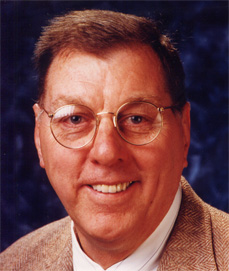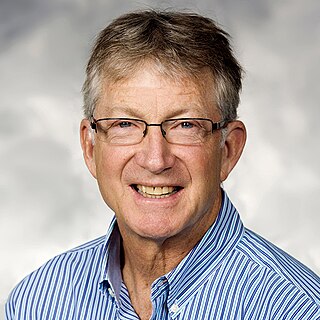Related Research Articles

The UC Berkeley College of Chemistry is one of the fifteen schools and colleges at the University of California, Berkeley. It houses the department of chemistry and the department of chemical and biomolecular engineering.

Paul Hugh Emmett was an American chemist best known for his pioneering work in the field of catalysis and for his work on the Manhattan Project during World War II. He spearheaded the research to separate isotopes of uranium and to develop a corrosive uranium gas. Emmett also made significant contributions to BET Theory which explains the relationship between surface area and gas adsorption. He served on the faculty of Johns Hopkins University for 23 years throughout his scientific career.

The University of Pennsylvania School of Engineering and Applied Science is the undergraduate and graduate engineering school of the University of Pennsylvania, a private research university in Philadelphia. The school offers programs that emphasize hands-on study of engineering fundamentals while encouraging students to leverage the educational offerings of the broader University. Engineering students can also take advantage of research opportunities through interactions with Penn’s School of Medicine, School of Arts and Sciences, and the Wharton School.

JoAnne Stubbe is an American chemist best known for her work on ribonucleotide reductases, for which she was awarded the National Medal of Science in 2009. In 2017, she retired as a Professor of Chemistry and Biology at the Massachusetts Institute of Technology.
Stanley Corrsin was an American physicist, fluid dynamicist, and Theophilus Halley Smoot Professor of Engineering at the Johns Hopkins University. He was known for his contributions in the field of fluid dynamics in general and turbulence in particular. He was a recipient of Fluid Dynamics Prize in 1983. Corrsin died of cancer on 2 June 1986 at the age of 66.

John A. Quinn was the Robert D. Bent Professor Emeritus of Chemical and Biomolecular Engineering at the University of Pennsylvania School of Engineering and Applied Science. He was a leader in the fields of mass transfer and membrane transport in synthetic membranes since the 1960s. In the early phase of his career at the University of Illinois, Quinn and his students devised simple, elegant experiments to elucidate the role of the interface in mass transfer between phases. In later work at Penn, he applied these insights to problems of engineering and biological significance involving chemical reaction and diffusion within and through both finely porous and reactive membranes. His chemical engineering science has informed matters as far afield as the separation of chiral pharmaceuticals and the behavior of cells at interfaces.

Chinedum Osuji is the Eduardo D. Glandt Presidential Professor and the departmental chair of chemical and biomolecular engineering (CBE) at University of Pennsylvania. He is also a former Taekwondo Olympian and represented Trinidad and Tobago. His laboratory works on polymers and soft materials for functional application including liquid filtration. He is the associate editor of the journal Macromolecules.
John C. Tully is a theoretical chemist, a researcher and Sterling Professor emeritus of Chemistry at Yale University. He is known for his development of surface hopping, a method for including excited states in molecular dynamics calculations. Much of his career was spent at Bell Labs, from 1970-1996, exploring theoretical chemistry and surface science. In 1996, he became a faculty member at Yale University, where he pursued research in physical chemistry and physics. He is a member of the National Academy of Sciences and the International Academy of Quantum Molecular Science. In 2020 he was awarded the NAS Award in Chemical Sciences.

Monica Olvera de la Cruz is a Mexican born, American and French soft-matter theorist who is the Lawyer Taylor Professor of Materials Science and Engineering and Professor of Chemistry, and by courtesy Professor of Physics and Astronomy and of Chemical and Biological Engineering, at Northwestern University.
Timothy P. Lodge is an American polymer scientist.

Judith P. Klinman is an American chemist, biochemist, and molecular biologist known for her work on enzyme catalysis. She became the first female professor in the physical sciences at the University of California, Berkeley in 1978, where she is now Professor of the Graduate School and Chancellor's Professor. In 2012, she was awarded the National Medal of Science by President Barack Obama. She is a member of the National Academy of Sciences, American Academy of Arts and Sciences, American Association for the Advancement of Science, and the American Philosophical Society.
John Michael Prausnitz is an emeritus professor of chemical engineering at the University of California, Berkeley.

Denis Wirtz is the vice provost for research and Theophilus Halley Smoot Professor of Engineering Science at Johns Hopkins University. He is an expert in the molecular and biophysical mechanisms of cell motility and adhesion and nuclear dynamics in health and disease.
Kimberly A. Prather is an American atmospheric chemist. She is a distinguished chair in atmospheric chemistry and a distinguished professor at the Scripps Institution of Oceanography and department of chemistry and biochemistry at UC San Diego. Her work focuses on how humans are influencing the atmosphere and climate. In 2019, she was elected a member of the National Academy of Engineering for technologies that transformed understanding of aerosols and their impacts on air quality, climate, and human health. In 2020, she was elected as a member of the National Academy of Sciences. She is also an elected Fellow of the American Philosophical Society, American Geophysical Union, the American Association for the Advancement of Science, American Philosophical Society, and the American Academy of Arts and Sciences.
Jin Zhang is a Chinese-American biochemist. She is a professor of pharmacology, chemistry and biochemistry, and biomedical engineering at the University of California, San Diego.

James L. Skinner is an American theoretical chemist. He is the Joseph O. and Elizabeth S. Hirschfelder Professor Emeritus at the University Wisconsin-Madison. He is also a member of the Scientific Advisory Board of the Welch Foundation. Most recently, Skinner was the Crown Family Professor of Molecular Engineering, professor of chemistry, director of the Water Research Initiative and deputy dean for faculty affairs of the Pritzker School of Molecular Engineering at the University of Chicago. Skinner is recognized for his contributions to the fields of theoretical chemistry, nonequilibrium statistical mechanics, linear and nonlinear spectroscopy of liquids, amorphous and crystalline solids, surfaces, proteins, and supercritical fluids. Skinner is the co-author of over 230 peer-reviewed research articles.
Nico van der Vegt is a Dutch chemist and a professor for computational physical chemistry at Technische Universität Darmstadt.
Kalina A. Hristova is a Bulgarian–American engineer. She is a professor of materials science and engineering at Johns Hopkins University's Whiting School of Engineering.
Barbara Jane Garrison is an American chemist who is emeritus professor at Pennsylvania State University. She is the former Shapiro Professor of Chemistry and head of the department. She is a Fellow of the American Physical Society, American Chemical Society, American Association for the Advancement of Science and American Vacuum Society.
Paulette Clancy is a British physicist who is Professor of Materials Science at Johns Hopkins University. Her research investigates the development of machine learning strategies to advance innovation in materials design, with a focus on complex situations.
References
- 1 2 3 4 5 6 7 "Kathleen Stebe Profile". seas.upenn.edu. Retrieved 2016-12-09.
- 1 2 3 4 "KATHLEEN J. STEBE Group". seas.upenn.edu. Retrieved 2016-12-09.
- 1 2 "Kathleen Stebe Seminar w/ Bio" (PDF). University of Connecticut. 2012. Archived from the original (PDF) on 2016-12-20.
- ↑ "ACIS 2017 – Speakers". Cvent. Archived from the original on 2017-01-06. Retrieved 2016-12-09.
- 1 2 Stebe, Kathleen. "Kathleen Stebe Linkedin". Linkedin.
- ↑ "National Academy of Engineering Elects 106 Members and 23 International Members". NAE. February 9, 2021. Retrieved 2021-02-10.
- ↑ "New members". American Academy of Arts and Sciences. 2020. Retrieved 2020-09-27.
- ↑ Henry, Lacey. "Past Inductees by Year". web.jhu.edu. Archived from the original on 2015-10-25. Retrieved 2016-12-09.